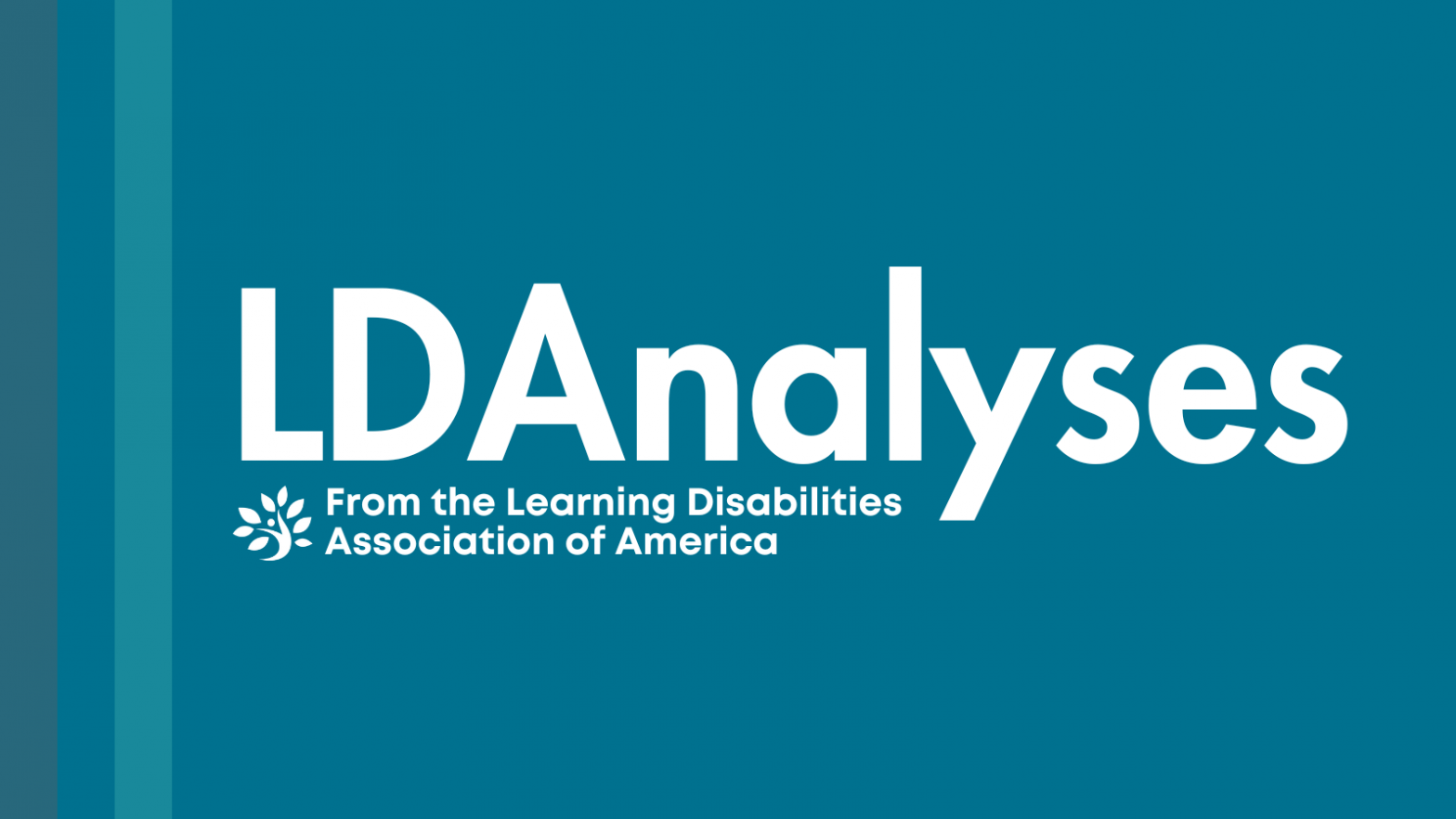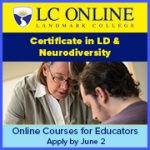Nancy Mather, Ph.D.
Monica McHale-Small, Ph.D.
David H. Allsopp, Ph.D.
Sarah VanIngen Lauer, Ph.D.
We have all been in this field for a very long time. Rumor has it (from attending the LDA 2024 Conference) that some professionals are once again suggesting that specific learning disabilities (SLD) is no longer a useful construct and perhaps should be replaced in the re-authorization of IDEA 2004 with classification based solely on low achievement (at or below the 5th percentile on standardized achievement measures) or even eliminated altogether. This recommendation for using low achievement as the criterion for special education is not new, but it is inconsistent with the concept of SLD (See Mather & Gregg, 2006), The purpose of this commentary is to examine why we still need to identify students with SLD, explain the main characteristics of SLD, and make a few suggestions for the revision of the SLD categories in the re-authorization of IDEA 2004.
The Concept of Unexpectedness
SLD was first categorized as a disability in the United States in 1975 with the passage of PL 94-142, but the existence of this disability was not created by this law. We have known about the existence of SLD for over a century. Case studies of these individuals can be found in the late 1800s. For example, Pringle Morgan (1896) discussed Percy, a bright 14-year-old boy, who: “… seems to have no power of preserving and storing up the visual impression produced by words – hence the words, though seen, have no significance for him. His visual memory for words is defective or absent which is equivalent to saying that he is what Kussmaul has termed ‘word blind.’ I may add that the boy is bright and of average intelligence in conversation…The schoolmaster who has taught him for some years says that he would be the smartest lad in the school if the instruction were entirely oral” (p. 1378).
Similarly, Hinshelwood (1902, 1917), a Scottish ophthalmic surgeon, described children with congenital word blindness as having average or above-average intelligence in other respects. He noted that many parents reported that their children apart from their reading difficulties were the most intelligent members of their families. Monroe (1932) also described numerous cases of children with reading disorders, some who were highly intelligent. She observed that “The children of superior mental capacity who fail to learn to read are, of course, spectacular examples of specific reading difficulty since they have such obvious abilities in other fields” (p. 23).
These early examples illustrate the concept of unexpectedness. Today, this concept is still explained in reference to the person’s intelligence or oral language, that is, the person has the intelligence or verbal abilities to be a much better reader. For example, in discussing the specific learning disability of dyslexia, Shaywitz and Shaywitz (2020) describe it as an unexpected difficulty in reading in an individual who has the intelligence to be a much better reader.
The Concept of Specificity
This unevenness among abilities illustrates the concept of specificity, another central theme of SLD. The word “specific” conveys the idea that not all abilities are low or impaired. Specificity indicates that the weaknesses in reading, writing, or math, do not affect other domains. Kavale and Forness (2000) explained that the addition of the adjective specific indicates that the poor academic performance experienced by students with SLD can be attributed to a limited number of underlying deficits (p. 245), which we might also understand as neurocognitive differences.
Travis (1935) described children who fail to learn to read or spell despite having adequate intelligence, as well as those who have a striking disparity between their ability in one subject and that in another. He explained that some children cannot read although they can comprehend the material when it is read to them, whereas other children present the opposite condition. He proposed that children who do not achieve as well as would be expected in a certain direction may be regarded as having a “special” disability. He explained that the clearest expression of this disability is consistently low scores in a given subject with average or superior scores on tests in other subjects.
For example, in the case of evidence for a reading disability, a student may have scores at the ninth-grade level in arithmetic, but at the third-grade level in reading. This unevenness in abilities would provide evidence of a striking reading disability; another child might indicate just as striking a disability in mathematics. Several decades later, Gallagher (1966) described these intraindividual differences as “developmental imbalances” meaning significant differences between the individual’s strengths and weaknesses. Since the last revision of IDEA, research uncovering some of the “underlying deficits” commonly seen in children struggling with reading, writing, or math has continued to amass.
Thoughts for the Revision of IDEA 2004
Given more recent advances in the neurocognitive underpinnings of learning, it merits discussing how this knowledge as well as other advances in evaluation and assessment can help us to revisit how to conceptualize the construct of SLD in the IDEA. Under the current IDEA, SLD includes the following eight categories: oral expression, listening comprehension, basic reading skills, reading fluency skills, reading comprehension, written expression, mathematics calculation, and mathematics problem solving. We would like to suggest some revisions to these eight categories.
Inclusion of oral language. More recent research related to oral language has led to an increased understanding of disorders specifically related to language (i.e., Developmental Language Disorders). Developmental Language Disorders (DLD) affect both oral expression and listening comprehension, two areas included in the IDEA definition of SLD. By continuing to include oral language (oral expression and listening comprehension) in the SLD definition, it creates confusion due to the overlap between the diagnostic categories of SLD and developmental language disorders (DLD).
Clearly weaknesses in oral language affect academic learning but these difficulties may often be better categorized as DLD, rather than SLD. High comorbidity exists between DLD and SLD but they are distinct disorders that require different interventions. In many cases, students who have SLD, but no other disorders, have a discrepancy between their average or above average oral language and one or more areas of academic performance.
Therefore, SLD seems to be best reserved for specific problems in the academic domains of reading (dyslexia), writing (dysgraphia), and mathematics (dyscalculia). When a student is struggling with reading comprehension, math applications and problem solving, or written expression, it can be difficult to determine when such difficulties are the result of a more global language disorder or rooted in weakness in cognitive processes such as working memory. Furthermore, SLD in these academic domains can also impact other areas, such as poor reading contributing to math problem solving, as well as the impact that SLD can have on a student’s social and emotional learning.
The category of written expression. As with categories of reading and mathematics, the area of written expression needs to include both written expression and basic writing skills. Students who have dysgraphia who struggle with handwriting and spelling often do not qualify for SLD as their ability to express their ideas in writing is not impaired. Also, a student with dyslexia, who has had systematic reading intervention, may have average scores in reading, but still demonstrate a significant weakness in spelling and require intervention.
As an example, consider the following writing sample from Aaron in Figure 1, a bright sixth-grade student, who has average reading scores. Aaron did not qualify for special education services, as the multidisciplinary committee concluded his difficulties were with basic writing skills, not with written expression. This writing sample demonstrates Aaron’s SLD in written expression (dysgraphia) and his need for systematic instruction in basic writing skills.

The category of mathematics. Additionally, we need to reconsider what is emphasized with respect to mathematics and the construct and evaluation of SLD. Currently, mathematics calculation (fact retrieval and computation) and mathematics problem solving (operationalized as word problems) are included in the definition. Although important, these areas are an incomplete representation of the mathematics curriculum and what is understood about the learning of mathematics and students with SLD in mathematics.
For a broader perspective, these two areas in the definition could be replaced with four categories: Number Sense, Mathematics Processes/Practices (used for problem solving), Mathematical Fluency (accuracy, efficiency, and strategy), and Mathematical Visual-Spatial Abilities. These four areas represent a more comprehensive treatment of mathematics that includes not only “calculation” and “problem-solving” but also the additional areas that get at the “what” of math (content), the “how” of math (doing math), and the “why” of math (conceptual understanding). Students who struggle in these areas can illustrate “symptoms” of a SLD in mathematics that can then be verified by an evaluation of relevant cognitive processing areas such as verbal working memory and visual-spatial processing that relate to math disabilities (Soares. et al., 2017), setting the stage for a robust way to determine patterns of strengths and weaknesses that can inform intervention.
Alternatively, the definitions and explanations of mathematics calculation and mathematics problem solving could be revised to better capture the breadth of mathematical deficits that are characteristic of SLD.
Three Procedures for Identifying SLD
The final concern about IDEA 2004 requirements are the three procedures that may be used to diagnose SLD: (1) the identification of a significant discrepancy between intellectual ability and achievement; (2) the use of other alternative research-based procedures, most often operationalized as a pattern of strengths and weaknesses (PSW) approach; and (3) a student’s response to evidence-based intervention, often referred to as response to intervention (RTI).
While an important process in determining which students are in need of a comprehensive evaluation, RTI should not be included as a way to diagnose SLD. There are many reasons why a student would not respond to a specific intervention and only one of the reasons is they have SLD. Whereas the first two procedures include the evaluation of targeted assessment data, both quantitative and qualitative, the RTI process often does not. RTI’s definition of SLD is not in alignment with the definitions of SLD outlined in major diagnostic manuals and seems best described as a school-wide framework for identifying and providing support to all struggling learners, regardless of the existence of a disability (Mather & Schneider, 2023).
Although problems exist with both, the other two criteria make sense. The ability-achievement discrepancy is an attempt to capture the unexpectedness of the adequate intelligence compared to the low achievement and may have utility in the evaluation of twice-exceptional students (Pennington et al., 2019). The PSW approach is an attempt to operationalize the concept of specificity and demonstrates that not all of the individual’s abilities are low, only the ones that are related to the disorder. While there are critics for all of these approaches with credible concerns, a PSW approach is most consistent with our past and current understanding of SLD.
Conclusions
Two basic concepts that are common among most definitions and have endured over time regarding SLD are: a specific pattern of strengths and weaknesses and unexpected learning failure (Kavale & Spaulding, 2008). Although formal assessment can provide useful quantitative and qualitative information, clearly the diagnosis of SLD involves more than just interpreting a student’s performance on standardized tests. For an accurate diagnosis, the evaluation team must also consider any previous diagnoses or comorbid disorders, such as DLD or ADHD; family history (e.g., any close relatives with SLD); school history and prior interventions; teacher, parent, and self-reports; social and emotional concerns; and current classroom performance. Because of the overlap among reading, writing, and mathematics disabilities, evaluators will want to consider comorbidity when one or the other is determined to exist.
Students with SLD exist and the category needs to be maintained as it is different than other types of disabilities. In discussing the dedication of their book, Stanger and Donahue (1937) said: “There are many poor readers among very bright children, who, because they are poor readers, are considered less keen than their classmates. This book should really be dedicated to the thousands of bright children thus misjudged” (p. 43). We cannot overlook the educational needs of these children.
References
Carpenter, T. P., Fennema, E., Peterson, P. L., Chiang, C. P., & Loef, M. (1989). Using knowledge of children’s mathematics thinking in classroom teaching: An experimental study. American Educational Research Journal, 26(4), 499-531.
Dennis, M. S., Calhoon, M. B., Olson, C. L., & Williams, C. (2014). Using computation curriculum-based measurement probes for error pattern analysis. Intervention in School and Clinic, 49(5), 281-289.
Gallagher, J. J. (1966). Children with developmental imbalances: A psychoeducational definition. In W. M. Cruickshank (Ed.), The teacher of brain-injured children (pp. 23-43). Syracuse University Press.
Hinshelwood, J. (1902b). Four cases of word-blindness. The Lancet, 159(4093), 358–363.
Hinshelwood, J. (1917). Congenital word-blindness. Lewis.
Hwang, J., & Riccomini, P. J. (2021). A descriptive analysis of the error patterns observed in the fraction-computation solution pathways of students with and without learning disabilities. Assessment for Effective Intervention, 46(2), 132-142.
Kavale, K. A., & Forness, S. R. (2000). What definitions of learning disability say and don’t say. Journal of Learning Disabilities, 33, 239-256.
Kavale, K. A., & Spaulding, L. S. (2008). Is response to intervention good policy for specific learning disability? Learning Disabilities Research & Practice, 23, 169-179.
Mather, N., & Gregg, N. (2006). Specific learning disabilities: Clarifying, not eliminating, a construct. Professional Psychology, 37, 99-106.
Mather, N., & Schneider, D. (2023). The use of cognitive tests in the assessment of dyslexia. Journal of Intelligence, 11, 79. https://doi.org/10.3390/jintelligence11050079
Moyer, P. S., & Milewicz, E. (2002). Learning to question: Categories of questioning used by preservice teachers during diagnostic mathematics interviews. Journal of Mathematics Teacher Education, 5, 293-315.
Monroe, M. (1932). Children who cannot read. University of Chicago Press.
Morgan, W. Pringle. (1896). Word blindness. British Medical Journal, 2, 1378. https://doi.org/10.1136/bmj.2.1871.1378
Pennington, B. F., McGrath, L. M., & Peterson, R. L. (2019). Diagnosing learning disorders: From science to practice (3rd ed.). Guilford.
Shaywitz, S., & Shaywitz, J. (2020). Overcoming dyslexia (2nd ed.). Alfred A. Knopf.
Soares, N., Evans, T., & Patel, D. R. (2018). Specific learning disability in mathematics: a comprehensive review. Translational Pediatrics, 7(1), 48.
Stanger, M. A., & Donohue, E. K. (1937). Prediction and prevention of reading difficulties. Oxford University Press.Travis, L. E. (1935). Intellectual factors. In G. M. Whipple (Ed.), The thirty-fourth yearbook of the National Society for the Study of Education: Educational diagnosis (pp. 37-47). Public School Publishing Company.
Travis, L. E. (1935). Intellectual factors. In G. M. Whipple (Ed.), The thirty-fourth yearbook of the National Society for the Study of Education: Educational diagnosis (pp. 37-47). Public School Publishing Company.
Authors
Nancy Mather is a Professor Emerita at the University of Arizona. She studied with the late Dr. Samuel Kirk, who is often referred to as the father of the field of learning disabilities. She is a co-author of two recent publications, Essentials of Dyslexia: Assessment and Intervention, 2nd ed.(Mather & Wendling, 2024) and the Tests of Dyslexia (Mather, McCallum, Bell, & Wendling, 2024).
Monica McHale-Small, Ph.D. is Director of Education for the Learning Disabilities Association of America. She retired after twenty-seven years of service in public education in Pennsylvania having served as a school psychologist and in various administrative roles including district superintendent. Monica has been an Adjunct Associate Professor of School Psychology at Temple University.
David Allsopp is a professor in the Department of Curriculum, Instruction, and Learning’s Exceptional Student Education program. David engages in Teacher Education research related to how teacher educators can most effectively prepare teachers to address the needs of students with learning disabilities and other struggling students especially in the area of mathematics.
Sarah van Ingen-Lauer is an Assistant Professor of Mathematics Education at the University of South Florida where she co-directs the innovative and nationally recognized Urban Teacher Residency Partnership Program. Dr. van Ingen Lauer collaborates with Dr. Allsopp to enhance teacher effectiveness with students with learning disabilities in mathematics.



